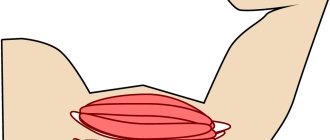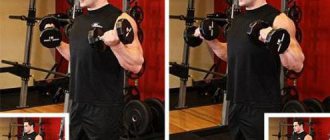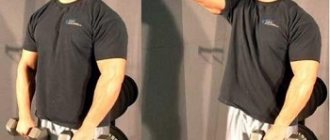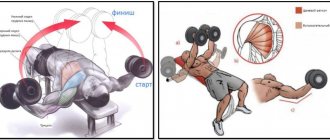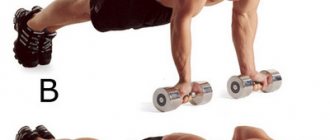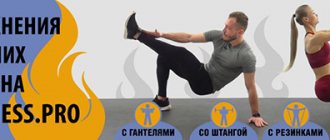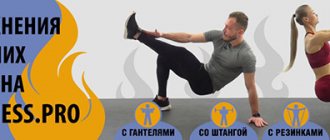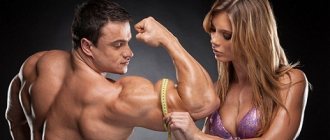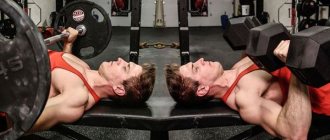What muscles does the concentrated biceps curl work?
From the very name of the exercise, concentrated biceps curl, we can understand which muscle is being emphasized.
We are talking about the biceps brachii muscle.
Most people call it biceps, but the essence does not change.
This muscle has 2 heads:
- Short. Which is located closer to the body. And despite the name, this head is larger in size. And the short one is the tendon.
- Long. It bears most of the load. After all, when he puts his elbow forward, this head is in the most extended position. Therefore, contraction in it occurs at full amplitude. But the short one, on the contrary, with this position of the elbow shrinks a little.
This is the main muscle group for the development of which we perform this exercise. But since we are bending the elbow joint, it means that two more muscles will be involved in any case. Such as:
- Brachialis. A small muscle located under the biceps. Together with him, he bends his arm at the elbow joint. Most involved in the initial phase of the movement.
- Brachioradialis. Or as it is also called, the brachioradialis muscle. It belongs to the muscles of the forearm. But it is also involved in elbow flexion and hand supination (rotation towards the thumb).
And of course there are muscles that stabilize our arm and shoulder. This:
- Triceps. Or the triceps muscle, the back of the arm.
- Deltoid muscles. These are the same muscles that most people mistakenly call shoulders.
As you can see, even though the exercise is isolated, the body still uses a large set of muscles to perform it.
Advantages and disadvantages of this exercise
Before we begin to analyze the technique and variations of this exercise. It wouldn’t hurt to talk about why we should do it at all. And there are several reasons for this:
Advantages
- Concentrated biceps curls are aimed at working the long head of the biceps. And if the talk about the effect of exercise on peak fitness is true, then that's a plus for us.
- The biceps work at the maximum available amplitude. No other exercise can achieve this.
- You don't need a lot of training equipment. What makes the exercise generally accessible in any gym. And if you wish, you can do it at home.
- The ability to work on each hand separately. This will have an extremely positive effect on the development of the biceps and reduces the imbalance of strength and form between the two sides.
- Excludes any assistance from other muscles. Of course, there is an option to help with a second hand. But on the contrary, it will help you complete the exercise to complete failure.
For me, this is a sufficient number of advantages for the exercise to be included in your training program. But before that, you should know about some disadvantages. Of course, they are not so significant, but you should still know about them.
Flaws
- The exercise is isolated, so the weight of the burden will be much less than in regular ARM BENDS WITH DUMBBELLS. This means that by performing these lifts we will not be able to increase the mass of the biceps.
- Since the movement is performed by each hand separately. Therefore, it takes twice as long to complete it. If you don’t have enough of this resource, you’ll have to choose other exercises.
- Not suitable for beginners. Since the presence of muscle mass in the arm is required.
Lifting the barbell for biceps technique and options
There are several options for lifting the barbell for biceps, they differ:
- grip (narrow, medium, wide, top, bottom);
- position (sitting, standing);
- and the neck (straight, curved).
For some, one or the other option is more suitable, and everyone can choose their own technique for effective training.
Features of the exercise
There are no identical people, as well as the forms of their skeleton - bones and joints. Therefore, what suits one person may be uncomfortable for another. For this purpose, special equipment has been developed - a curved bar, the grip of which can reduce the load on the joints. You can also choose a grip width that does not cause pain; in any case, for effective training there must be a variety of exercises.
What muscles work
- The main muscles that work when lifting a barbell for biceps with an overhand grip are the brachioradialis and brachialis muscles, extensors of the wrist and fingers, and to a lesser extent, the biceps brachii.
- The muscles that work when lifting the barbell for biceps with a reverse grip are the biceps brachii and the brachialis muscle.
Technique for standing biceps exercises with a barbell
The exercise is performed with a straight bar with a medium grip:
- Standing, feet shoulder-width apart, knees slightly bent (relieve the load from the knees).
- Grasp the bar from below, slightly wider than your shoulders.
- Exhale: bend your arms, lifting the barbell using the efforts of your biceps.
- Inhale: smoothly lower the barbell down.
It is important not to rock your body! To avoid this, you can rest your back against the wall, moving your feet slightly forward. Total 4x8-12
Total 4x8-12.
Narrow grip
Works the long head of the biceps, involves bringing the palms closer to each other so that the hands are located on the front surface of the thighs (the joints of the hands are narrower than the shoulder joints).
Exercise technique (classic version)
To begin with, we will look at the classic sitting option, which is the most popular. To perform it we will need a dumbbell and a bench press.
Initial position:
- Place the bench press in a horizontal position.
- Take a dumbbell in one of your hands and sit on a bench. Spread your legs to the sides.
- Lean your body forward slightly. Place the palm of your free hand on the thigh of the same leg. We lower the hand with the dumbbell down so that it is perpendicular to the floor. And we rest the area just above the elbow on the inner thigh of the leg.
We will begin the exercise from this position.
Performance:
- As you exhale, begin to bend your arm at the elbow. Thus, we raise the dumbbell up, as close as possible to the opposite shoulder. At the top point, press the dumbbell until you feel the peak contraction of the biceps
- Then, as you exhale, slowly and under control, extend your arm and return to the starting position.
- Having finished doing the specified number of times on one hand, transfer the dumbbell to the other. And repeat the same steps step by step.
Performing a concentrated biceps curl from a seated position. We can exclude stabilizer muscles from the exercise. All thanks to the leg on which we rest our hand. It acts as additional support. We also completely eliminate body swaying from side to side. This means that we will not be tempted to throw the dumbbell in the last repetitions by lifting the shoulder and turning the torso. Therefore, this option is recommended for those people who have just started doing concentrated lifts and have not yet mastered the technique perfectly.
Execution Rules
1) I repeat once again, when performing the exercise, the elbow rests just slightly above the knee, but not in the groin or in the center of the thigh.
2) It is necessary to lower and raise the dumbbell with a strictly fixed body, do not swing it, raising and lowering the dumbbell is due to a concentrated load with the strength of the biceps muscles.
3) The exercise can be done with rotation of the hand (supination), that is, when you lower the dumbbell, the hand gradually turns around and looks at the body at the lowest point.
4) You need to lift the dumbbell until the dumbbell touches your chest. Try to rotate your hand slightly outward at the top point so that your little finger is higher than your thumb, this will enhance the peak contraction of the biceps and completely finish off the already tired muscle after basic exercises.
5) If you are a beginner, do not include this exercise in your workouts yet, it helps more to shape the beauty of your biceps than to grow muscle mass in your arms.
Execution options
In addition to the classic version, there are several varieties of this exercise. In terms of execution, they are absolutely similar, the only difference is in the starting position.
Standing concentrated dumbbell lift
This is a more difficult version of this exercise. Which requires maximum concentration during its implementation. But we no longer need a bench for pressing. Consequently, the chances increase that the equipment we need will be free in the hall. Unlike the sitting option, we will not rest the hand with the dumbbell on the leg. This means our stabilizers, triceps and deltoids, will actively work in static tension. This will definitely help strengthen them. But at the same time there is a chance to start an unfair game. I mean throwing a dumbbell by twisting your torso. This mainly happens at the end of the exercise, when the athlete is no longer able to perform the repetitions. Or if he takes on too much weight that does not correspond to his level of physical development. Therefore, I strongly recommend that you keep an eye on this! Doing this exercise like this will only make things worse for you. It's not called concentrated for nothing. That is, our main task is to concentrate on the work of the biceps, and not just squeeze the dumbbells.
Initial position:
- Take dumbbells in one of your hands (it is preferable to start with the weaker one, usually the left one).
- Spread your legs wider than shoulder-width apart. And bend them at the knees a little
- The body leaned forward. At the same time, the back should remain straight. No need to slouch too much.
- With the elbow of our free hand, we can rest against the knee of the leg of the same name. If you want to achieve even greater stability, then place the palm of the same hand on the opposite knee.
- We lower the hand with the dumbbell down so that it is perpendicular to the floor.
From this position we will do the exercise using the same method as written above.
Concentrated lift in the pad exerciser
This option is extremely rare, but still occurs. It is also performed from a standing position. Only instead of a dumbbell, the cable of a block exercise machine will act as a weight, with a D-shaped handle installed. Thanks to this, we can increase the load on the biceps, especially in the upper position. After all, now we will need to not only overcome the weight of the burden, but also the resistance force of the cable. Which will try to straighten our hand. If you don't feel your biceps working while performing concentrated lifts, then this option can help you. But it’s worth considering that the block simulator itself is popular and is not always free. Therefore, sometimes you will need to wait until it is free. Or even postpone this exercise until later.
Initial position:
- Place the pulley cable in the down position and secure the D-handle.
- Select the number of blocks you need by setting a limiter there.
- Grab the handle and move a little to the side to tighten the cable.
- We take the same position as in the standing version.
- Spread your legs and lean forward. We place our free hand on our thigh, and lower the one in which the cable is held so that it is perpendicular to the floor.
These are all options that you can use in your workouts.
Need to remember
In order to achieve good results, follow a few basic rules:
- choose any exercise option that suits you: it can be done standing or sitting, with dumbbells or with a barbell, with or without wrist rotation - which method to choose depends on physiology and personal preferences;
- perform the lift slowly and without jerking, feel the biceps working throughout the entire repetition;
- do a peak contraction at the top point, fixing the position for two to five seconds and contracting the biceps as much as possible;
- When doing lifts, do not bend your body to the sides, keep your spine in a neutral position.
Recommendations for implementation
- Don't forget that the exercise is isolated. This means that it is not designed to handle heavy weights. Therefore, there is no need to set records in it. It is better to choose a multi-repetition mode of 12-20 repetitions.
- Your core should remain motionless throughout the entire execution. Forget about cheating in this exercise.
- In a sitting position, you do not need to move your working hand away from your hip. And in the standing version, swing it from side to side.
- When raising your arm, do not bend your wrist. This way you can injure it and at the same time reduces the load on the biceps.
- You can also strengthen the biceps work a little. To do this, use supination of the forearm during lifting. That is, we rotate the hand towards the thumb.
- Do not relax your hand while lowering. This way you can injure your elbow joint and there is no question of any concentration. Therefore, we must control the weight of the resistance in both the concentric (lifting) and eccentric (description) phase.
- Don't relax your hand completely at the bottom. Maintain a slight fold. This will keep your biceps under constant tension.
- And the most important thing!
While lifting, try to bring your forearm as close to your biceps as possible. The sharper the angle in your elbow joint, the more the biceps muscle will be loaded.
Check out each of these tips and be sure to use them when performing concentrated bicep curls.
Incorporating exercise into your workout
Thinking, I managed to emphasize that the exercise is isolated. This means that doing it at the beginning of training is inappropriate. This way we will only tire out the biceps and then we will not be able to reveal its potential in basic exercises.
Therefore, if you decide to use this exercise, then make a place for it at the end of your workout. Then you will be able to finish off your already tired biceps and get all the juice out of it.
The approaches are not so important here. Our main task is to reach failure. But don't get carried away. If after 3 sets you feel like you can still do 4. Then increase the weight or number of repetitions a little.
Errors during execution
There are not many mistakes as such when performing this exercise. Basically they all happen for one reason. And this is too much weight.
As soon as we take a huge dumbbell, our technique automatically becomes incorrect. And we begin to make a number of other mistakes:
- Bending the arm by inertia due to swinging of the body and arm
- Washing the elbow from the hip and shifting the arm in a standing position.
All this will not bring us any results. We'll only hurt our elbow. And with such an injury, you can completely forget about training. Therefore, choose the weight correctly! And your biceps will become big and lumpy.
Good luck to everyone in your training!
Variations of the exercise
You can perform this exercise while standing with your body tilted forward. In this case, the hand with the dumbbell hangs freely. The palm of the hand with the dumbbell is turned forward. But in this case, you need to carefully ensure that when bending the elbow moves as little as possible.
Concentrated dumbbell curls
Concentrated dumbbell curls
Exercises with dumbbells. Home workout program. Arm curls with dumbbells sitting from the knees Zottman curls Arm curls with dumbbells sitting on an incline bench
Tags: isolated arm muscle exercises
TRAINING COURSE FOR HOME
Ready-made sets of exercises for self-study at home.

